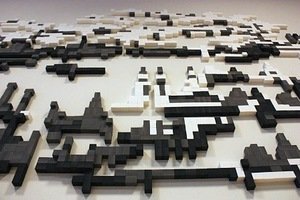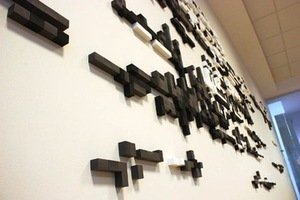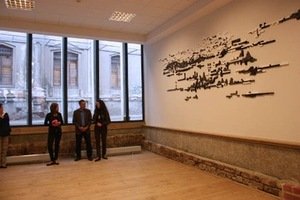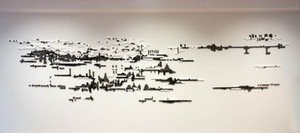CONNECTING MEMORY IN THE INSTALLATION 'CLOUDS OVER KAUNAS' BY P. GILYTĖ 0
In brief: The site-specific installation ‘Clouds over Kaunas’ by Patricija Gilytė was presented at Kaunas Kolping College in September. The artist arranged pieces of foam in order to convey a real and imaginary map of Kaunas city: ‘In this work I combine architectural forms of the Old Town and the suburbia, silhouettes of trees and houses, a linear similarity of rivers and streets into a multi-stage plain. Trying to decipher it as a subjective map is every time different depending on the perspective of a viewer.’
The memory of the individual turns the true image seen in reality subjectively: it records some objects stronger and pushes other ones deeper for some reason. That is how the artist combined the earlier city memories with the new ones, where ‘the past and the present do not have clear limits’.
The ‘Clouds over Kaunas’ is a large-sized work, which structure and inner logic are based on the architectonics of Kaunas city and also the author’s personal experience, point of view and memory. The author does not try to follow nature implicitly. The image placed on the wall does not recreate the real relation among the city’s objects. A deliberate manipulation of image (compression or extension) is important as a metaphor to P. Gilytė.
The information accumulated in the subconscious is integrated and becomes a part of the image. The wall covered in pixels can be also perceived as placing the whole film (or place, or story) into one plain.
At the same time this work of art is an example of the postmodern society in terms of scattering as a technique that the author chooses. The artist depicts the cityscape in foam pixels that are not a solid means. The installation consists of many separate segments. The artist achieves the impression of depth in the wall by assorting three colours (white, black, grey) of foam pixels. The ‘Clouds over Kaunas’ creates the impression of the wholeness only after stepping back from the installation.
The installation is designed for rather a narrow area – Kaunas city. However, the concept of the ‘city’ involves not only the natural and architectural landscape or citizens but also those people who have visited or heard about some certain places of the city. Such tourists also have their subconscious city panorama. ‘Creating works that rarely can be moved and shown elsewhere, I work exclusively for the viewer who visited the place, for the certain time and its context’, - the artist declares.
The city is a formation that changes in time. The surroundings – human beings and nature – keep on transforming it. That is why a certain image of the city can be a direct experience-recollection of a certain individual for some certain period only. Architectural objects remain in the images of the memory most often; they evoke associations of civilisation as a synonym of a city.
In her site-specific work attached to the wall the artist conveys her personal relation to Kaunas. By choosing the foam as ‘a material that absorbs the surroundings rather than reflects it’, the author renders ‘a soft line between the past and the future’. Using similar components, P. Gilytė creates the most individual object – her personal city. The city as she knew it in the past and as she knows it now. With the help of inner images as a highly personal and authentic object of creating art, P. Gilytė examines the relativity of time in terms of every individual and their experience.












